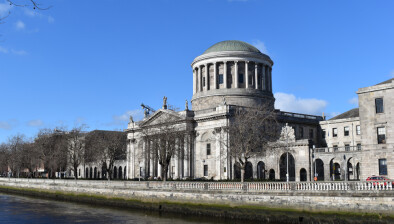Killian Flood: In upholding the Personal Injuries Guidelines, one Supreme Court judge hinted at further reform

Reform in personal injuries law has been a focus of government and the insurance sector in recent years. Killian Flood examines how one Supreme Court judge recently signalled a willingness to consider reforming the standard of care in certain cases.
Last week, the Supreme Court delivered the much-anticipated ruling on the validity of the Personal Injuries Guidelines, which generally cut the awards of damages in personal injuries cases following their introduction in 2021. In short, the Supreme Court determined that the guidelines were validly introduced and remain in force, although the seven judges had very different reasons for reaching this conclusion.
This is about as much as anyone needs to know for now. The five judgments containing 422 pages of dense constitutional analysis will be parsed by unfortunate lawyers in the coming years, but this really was a case where interested parties only cared about the result. Although a majority of the court held that the adoption of the guidelines by the Judicial Council was unconstitutional, the legal status of the guidelines was held to be valid for other reasons. No insurer will care that they got the sporting equivalent of an ugly one-nil away win on this one.
And so, for the first time since the initiation of Bridget Delaney’s challenge in June 2021, we have certainty as to the legal standing of the guidelines. Whatever one might think about their content, it is undoubtedly in everyone’s interest to know that the guidelines have legal effect. Before now, there was always a nagging concern in advising a client to accept or reject a particular sum in settlement of a personal injuries action due to Ms Delaney’s challenge, whereas now such concern has dissipated.
It is notable that it took the Supreme Court fourteen months to deliver a decision that was of urgent public import. The constitutional issues were complex and there was clear disagreement between the seven judges in their reasoning which surely caused much debate behind the scenes. However, it was also true that tens of thousands of personal injuries claims were affected by the outcome of the proceedings, so time was not an unlimited resource.
In reality, any delay in delivering judgment was not consequential as the status quo was affirmed. Of far greater interest was a hint by one judge that the law relating to liability in personal injuries cases ought to be reconsidered.
Standards of ordinary care
Specifically, Mr Justice Charleton said that “consideration as to why tripping on the pavement and in what circumstances may establish liability on a local authority, or gas or water company, as are the common defendants, should be undertaken” (Ms Delaney’s claim was that she had tripped on a defective footpath maintained by Waterford City & County Council).
The judge went on: “The law of negligence is about establishing standards for ordinary care. Thereby, society is ordered for the better. Impossible standards break the reasonableness test and do not in any way assist in that task. People are generally aware that a public street is not a carpeted interior and so they look out for themselves. What degree of negligence arises if there is a visible flaw in a pavement, if there is liability, what degree of contribution to the damage would someone not taking care be assessed at?”
These comments are surprising for a number of reasons, in part for the fact that they were made at all. Ms Delaney’s appeal had nothing to do with the merits of her claim and yet, Mr Justice Charleton felt the need to signal potential issues with liability in the proceedings. As such, it might be inferred that this is a matter that has been on the judge’s radar for some time.
Moreover, the comments are notable because they sit at odds with the prevailing understanding of lawyers that a local authority bears responsibility for the state of public footpaths and will be liable if accidents occur. Obviously, a plaintiff will face allegations of contributory negligence where they have tripped over a hazardous footpath, but even so, it is usually not the case that a local authority will escape liability entirely.
By openly questioning the degree of liability attaching to local authorities in such cases, it appears that Mr Justice Charleton would welcome an opportunity to re-establish and (perhaps) recast the obligations owed to pedestrians by local authorities. We do not know how any such case would ultimately be decided, as Mr Justice Charleton makes no definitive statement on the issue and other judges may not feel the same way.
However, the willingness of Mr Justice Charleton to highlight the liability issue should be noted by lawyers on both sides of the aisle. After all, it is not often that a senior judge in the Supreme Court will suggest that a particular area of the common law should be addressed.
Wider consequences
Any such decision could have wider consequences for personal injuries law. If we imagine for a moment that the Supreme Court lowered the standards of care owed to pedestrians by local authorities, it is not hard to envisage the standards of care being lowered in other cases. For example, I am not sure there is too much difference between a person who trips on a faulty pavement and a person who slips on a rogue grape in the supermarket. If the standard of care is lowered in the first instance, could it follow that it should be lowered in the second?
Such speculation is not valuable in the absence of a pending appeal before the courts, but it is a natural digression from Mr Justice Charleton’s comments. Undoubtedly, insurers would jump at the opportunity to refashion the common law duty of care, particularly in light of recent victories in personal injuries awards, the pre-litigation process and the rebalancing of occupier’s liability in the Courts and Civil Law (Miscellaneous Provisions) Act 2023.
Indeed, when viewing recent developments in personal injuries law in the round, it seems that the days of the “have-a-go” plaintiff action are numbered as the risks of adverse results or negligible reward will simply be too great. That being so, reductions in insurance premiums should be a mere formality, though I won’t be holding my breath.
Mr Justice Charleton concluded his comments by saying: “An appropriate case awaits analysis.” If they have any sense, local authorities will be actively looking for such a case. The insurers may not be too far behind them.









